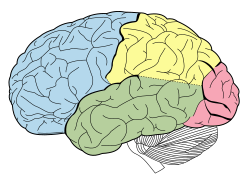Neuropsychologists commonly work in hospitals. There are three main variations in which a clinical neuropsychologist may work at a hospital: as an employee, consultant, or independent practitioner. [9] A clinical neuropsychologist working as an employee of a hospital would receive a salary, benefits, and have a contract for employment. [9] The hospital is in charge of legal and financial responsibilities for their neuropsychologists. [9] The second option of working as a consultant implies that the clinical neuropsychologist is part of a private practice or is a member of a physicians group. [9] In this scenario, the clinical neuropsychologist may work in the hospital like the employee of the hospital but all financial and legal responsibilities go through the group which the clinical neuropsychologist is a part of. [9] The third option is to be an independent practitioner, who works alone and may even have their office outside of the hospital or rent a room in the hospital. [9] In the third case, the clinical neuropsychologist is completely on their own and in charge of their own financial and legal responsibilities. [9]
Assessment
Assessments are used in clinical neuropsychology to find brain psychopathologies of the cognitive, behavioral, and emotional variety. [10] Physical evidence is not always readily visible so clinical neuropsychologists must rely on assessments to tell them the extent of the damage. [10] The cognitive strengths and weaknesses of the patient are assessed to help narrow down the possible causes of the brain pathology. [10] A clinical neuropsychologist is expected to help educate the patient on what is happening to them so that the patient can understand how to work with their own cognitive deficits and strengths. [10] An assessment should accomplish many goals such as; gauge consequences of impairments to quality of life, compile symptoms and the change in symptoms over time, and assess cognitive strengths and weaknesses. [10] Accumulation of the knowledge earned from the assessment is then dedicated to developing a treatment plan based on the patient's individual needs. [10] An assessment can also help the clinical neuropsychologist gage the impact of medications and neurosurgery on a patient. [10] Behavioral neurology and neuropsychology tools can be standardized or psychometric tests and observational data collected on the patient to help build an understanding of the patient and what is happening with them. [10] There are essential prerequisites which must be present in a patient in order for the assessment to be effective; concentration, comprehension, and motivation and effort. [10]
Although assessments have been done manually by neuropsychologists, advances have been made where AI is now being used to help make assessments easier to understand. In the 2010s, machine learning had already made progress, but it was only towards the 2020s that full access to AI led to massive improvements in performance as an assessment tool. Machine learning originally had it’s first fast advances in 2017 which is reviewed in an academic journal by Frontiers in Aging Neuroscience [11] . They discovered that machine learning was an aid in neuropsychological tests to find out if someone has Alzheimer’s, in comparison to whether they find a different cognitive dysfunction within the patient. It is recorded that machine learning has high accuracy in its assessment of individuals who may have cognitive impairment.
Past the 2020s, full implementation of AI for diagnostics became apparent when its use exists for clinical neuropsychology by using it to primarily assess whether someone has Alzheimer’s. AI has become prevalent for leading in early diagnosis of discovering whether someone is slowly developing Alzheimer’s. It has been noted that machine learning has been more effective in assessment in comparison to human neurologists [12] . Machine learning has been noted as having an accuracy that isn’t inefficient; the use of support vector machines (SVM) had a quoted accuracy of 77.17% [13] .
Lezak lists six primary reasons neuropsychological assessments are carried out: diagnosis, patient care and its planning, treatment planning, treatment evaluation, research and forensic neuropsychology. [14] : 5–10 To conduct a comprehensive assessment will typically take several hours and may need to be conducted over more than a single visit. Even the use of a screening battery covering several cognitive domains may take 1.5–2 hours. At the commencement of the assessment it is important to establish a good rapport with the patient and ensure they understand the nature and aims of the assessment. [15]
Neuropsychological assessment can be carried out from two basic perspectives, depending on the purpose of assessment. These methods are normative or individual. Normative assessment, involves the comparison of the patient's performance against a representative population. This method may be appropriate in investigation of an adult onset brain insult such as traumatic brain injury or stroke. Individual assessment may involve serial assessment, to establish whether declines beyond those which are expected to occur with normal aging, as with dementia or another neurodegenerative condition. [14] : 88
Assessment can be further subdivided into the following sub-sections:
Neuropsychological assessments usually commence with a clinical interview as a means of collecting a history, which is relevant to the interpretation of any later neuropsychological tests. In addition, this interview provides qualitative information about the patient's ability to act in a socially apt manner, organise and communicate information effectively and provide an indication as to the patient's mood, insight and motivation. [16] : 58 It is only within the context of a patient's history that an accurate interpretation of their test data and thus a diagnosis can be made. [16] : 44 The clinical interview should take place in a quiet area free from distractions. Important elements of a history include demographic information, description of presenting problem, medical history (including any childhood or developmental problems, psychiatric and psychological history), educational and occupational history (and if any legal history and military history.) [16] : 47–58
- Performing a set of neuropsychological tests
It is not uncommon for patients to be anxious about being tested; explaining that tests are designed so that they will challenge everyone and that no one is expected to answer all questions correctly may be helpful. [15] An important consideration of any neuropsychological assessment is a basic coverage of all major cognitive functions. The most efficient way to achieve this is the administration of a battery of tests covering: attention, visual perception and reasoning, learning and memory, verbal function, construction, concept formation, executive function, motor abilities and emotional status. Beyond this basic battery, choices of neuropsychological tests to be administered are mainly made on the basis of which cognitive functions need to be evaluated in order to fulfill the assessment objectives. [17]
Following a neuropsychological assessment it is important to complete a comprehensive report based on the assessment conducted. The report is for other clinicians, as well as the patient and their family, so it is important to avoid jargon or the use of language which has different clinical and lay meanings (e.g. intellectually disabled as the correct clinical term for an IQ below 70, but offensive in lay language). [16] : 62 The report should cover background to the referral, relevant history, reasons for assessment, neuropsychologists observations of patient's behaviour, test administered and results for cognitive domains tested, any additional findings (e.g. questionnaires for mood) and finish the report with a summary and recommendations. In the summary it is important to comment on what the profile of results indicates regarding the referral question. The recommendations section contains practical information to assist the patient and family, or improve the management of the patient's condition. [18]

